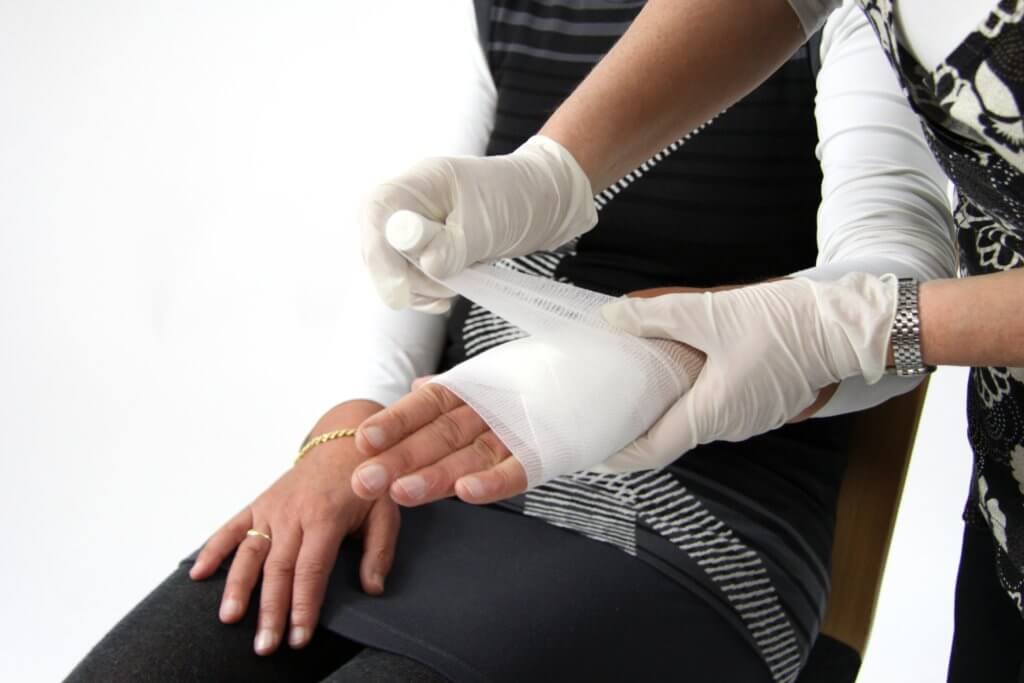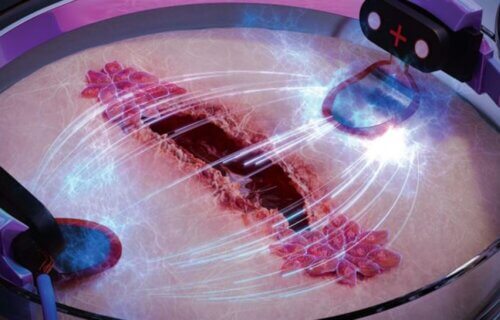GOTHENBURG, Sweden — For sedentary elderly and diabetic patients, chronic wounds are a persistent health threat. However, researchers from Chalmers University of Technology in Sweden and the University of Freiburg in Germany have now developed a way to make the healing process three times faster — using electricity!
“Chronic wounds are a huge societal problem that we don’t hear a lot about. Our discovery of a method that may heal wounds up to three times faster can be a game changer for diabetic and elderly people, among others, who often suffer greatly from wounds that won’t heal,” says Maria Asplund, Associate Professor of Bioelectronics at Chalmers University of Technology and head of research on the project, in a media release.
The team based their work on an old hypothesis that skin cells are electrotactic, meaning they directionally “migrate” in electric fields. In other words, if a field is placed in the same petri dish as skin cells, the cells will move toward it. To see how this could be applied to wound healing, the researchers used a small, engineered chip to compare wound healing in artificial skin, stimulating one wound with electricity and letting one heal without it. The differences were eye-catching.
“We were able to show that the old hypothesis about electric stimulation can be used to make wounds heal significantly faster. In order to study exactly how this works for wounds, we developed a kind of biochip on which we cultured skin cells, which we then made tiny wounds in. Then we stimulated one wound with an electric field, which clearly led to it healing three times as fast as the wound that healed without electric stimulation,” Asplund says.

Stimulating diabetic cells speeds up their recovery
The study authors also explored diabetic wounds, with electrical stimulation showing similarly promising results.
“We’ve looked at diabetes models of wounds and investigated whether our method could be effective even in those cases. We saw that when we mimic diabetes in the cells, the wounds on the chip heal very slowly. However, with electric stimulation we can increase the speed of healing so that the diabetes-affected cells almost correspond to healthy skin cells,” Asplund explains.
The future is bright for the Chalmers team, thanks to a large grant to expand their research efforts and develop wound healing products down the road.
“We are now looking at how different skin cells interact during stimulation, to take a step closer to a realistic wound. We want to develop a concept to be able to ‘scan’ wounds and adapt the stimulation based on the individual wound. We are convinced that this is the key to effectively helping individuals with slow-healing wounds in the future,” Asplund concludes.
The findings are published in the journal Lab on a Chip.
Best tips for everyday wound care
To improve wound healing without electrical stimulation, here are some top suggestions to help cuts and scrapes go away faster:
- Keep the wound clean: Gently clean the wound with soap and water or a saline solution to remove debris and bacteria, which can help prevent infection and promote faster healing.
- Keep the wound moist: Apply a thin layer of antibiotic ointment or hydrogel to the wound, which can help prevent infection and promote a moist environment that encourages healing.
- Use an appropriate dressing: Choose a dressing that maintains a moist environment and protects the wound from contaminants. Options include hydrocolloid dressings, foam dressings, and alginate dressings.
- Change dressings regularly: Replace dressings as needed or according to the healthcare provider’s recommendations to maintain a clean and moist environment for the wound.
- Elevate the affected area: If possible, keep the injured area elevated above heart level to reduce swelling and promote blood flow to the area, which can speed up healing.
- Maintain a healthy diet: Consume a balanced diet rich in vitamins, minerals, and protein to support the body’s healing process. Vitamins A, C, and E, zinc, and omega-3 fatty acids are particularly beneficial for wound healing.
- Stay hydrated: Drink plenty of water to support overall health and help transport nutrients and oxygen to the wound site.
- Avoid smoking and alcohol: Both smoking and alcohol consumption can impair the body’s ability to heal by reducing blood flow and compromising the immune system.
- Get adequate sleep: Sleep is essential for the body’s repair processes. Aim for seven to nine hours of sleep per night to support wound healing.
- Control underlying medical conditions: Manage any pre-existing conditions like diabetes or vascular disease, as they can negatively impact the healing process.
- Follow healthcare provider’s instructions: Adhere to any specific recommendations provided by your healthcare provider, including taking prescribed medications and attending follow-up appointments.
This advice is not a substitute for professional medical care. Always consult a healthcare provider for personalized recommendations and treatment options.
You might also be interested in:
- Deep brain stimulation emerges as promising Alzheimer’s treatment
- Revolutionary spinal cord stimulation is helping patients regain arm mobility after a stroke


Sometime in the mid-90’s, my wife opened the freezer door and a frozen Turkey fell out and landed on her big toe. Yes, it was now broken (not the Turkey), as evidenced by an x-ray. 6 or more weeks went by and the toe was not healing. Now we are worried the toe might have to be removed. BUT!! I remembered a personal experience of my own, whereby I placed an electric current from a device with patches I used on my back for pain to the wound I had, and it was completely healed in about two weeks. This device is similar to an Empi used for pain treatment.
I placed a similar device onto the big toe of my wife and two weeks later re-x-rayed it…….it was completely healed. I don’t think I told the doctor this – someone would have these devices removed from the public availability. (You know what I’m talking about).
DISCLAIMER: DO NOT ATTEMPT TO USE A HOT WIRE PLUGGED INTO A WALL SOCKET WHICH WILL LEAD TO ELECTROCUTION.
Discuss this with your doctor, or a naturopath.